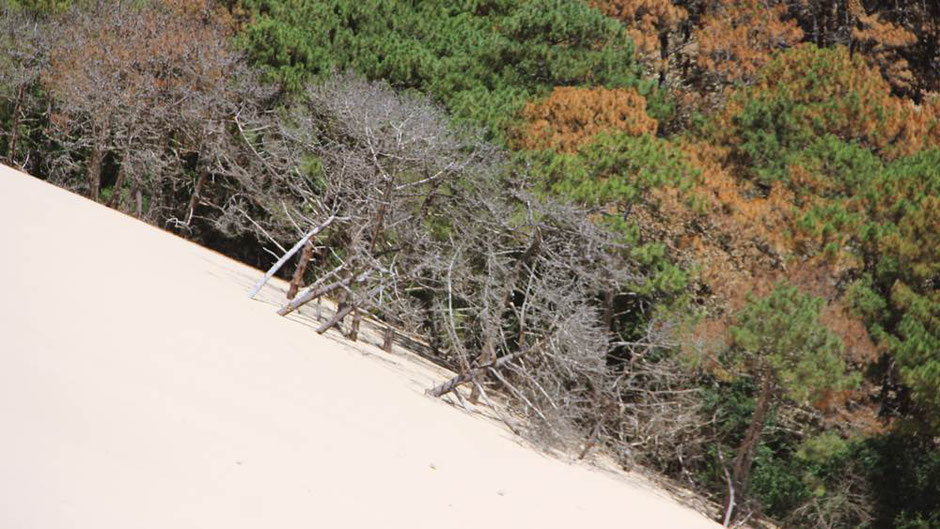Is the dune in danger?
The Dune du Pilat is often described as "fragile", and even before the forest fire in July 2022, many were asking questions about its future. The question is still relevant, and the French
broadcaster France 2 tried to answer it on 20 July 2022, immediately after the fire was contained.

is The forest protecting it?
The photo above from 27 July 2022 shows three types of trees:
1 - trees without needles, dead but obviously not burnt
2 - green trees, obviously unharmed
3 - brown trees, obviously burnt
Many are worried about the dune and believe that it will lose height as the forest has "disappeared" in the fire. As you can see in this photo, the forest is still there, the trees, even though
burnt, are still standing for the most part. They will certainly be felled after a period of observation, when it is certain that they can not be saved. However, there is some hope that the trees
that are still green will be able to remain standing (some will certainly die as their trunks are likely to be severely affected). The needle-less trees that were spared by the flames here are
already dead - smothered by the sand, swallowed by the dune in a long but steady and unstoppable process. You can also see that the sand is not held back at all by the tree trunks. The fine
grains of sand run right past the trunks as if there were no obstacle at all, and these trees will eventually be completely covered by them.
Conclusion: If the forest were indeed a "rampart" or "bulwark" for the dune, the dune would not be in immediate danger because the trees are still standing. Nevertheless, the next question
arises: if even the trunks standing directly at the foot of the dune cannot stop the sand and thus cannot "protect" the dune, how could the trees standing 5, 20, 50 or 200 metres from the foot of
the dune do so?
The idea of a "bulwark" is all the more astonishing because all these trees are to the east (!) of the dune, although the wind normally comes from the west. The forest was and is therefore not
able to reduce the impact of the prevailing winds, as the dune with its 106 metres height far exceeds the height of the trees. A function as a "bulwark" to stabilise the dune or slow down its
migration has not been proven and seems unlikely, if not impossible.
© Detlef Bogs/www.dunedupilat.com, 01-08-2022
Note: This text was written by a layman and the considerations are based solely on observations made over the years and taking into account the available information. I am happy
to supplement and/or correct this information with scientific evidence. If you are an expert, researcher etc. and would like to confirm or refute this information and add scientific data,
please contact me. I would be really grateful for this!
More information (in French):
https://www.radiofrance.fr/franceinter/incendies-les-forets-ravagees-autour-de-la-dune-du-pilat-quelles-consequences-pour-la-biodiversite-9006146
https://www.ouest-france.fr/faits-divers/incendie/gironde-pourquoi-la-dune-du-pilat-est-fragilisee-par-les-incendies-346ded6c-08f3-11ed-809f-9e7ceb27185e
